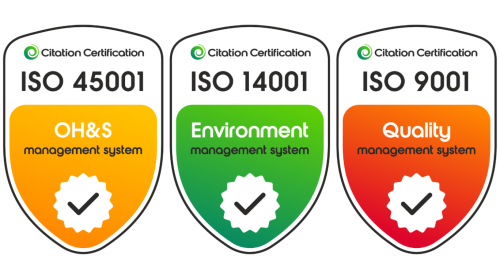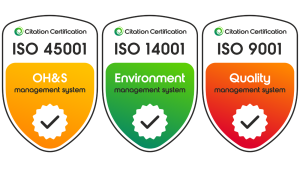Environmental Responsibilities

What are Environmental Aspects & Impacts?
Environmental Aspects are an element of an organization’s activities, products or services that can interact with the environment. Companies must address the aspects that relate to their works and gain an understanding of the impacts associated. This allows for the development and implementation of management plans, policies, and procedures to mitigate and control the impacts on the environmental as a result of works conducted by the company. It allows for companies to meet the requirements of their clients and regulation as well as maintain a proactive, planned, and driven approach to Workplace Health and Safety, Quality, and the Environment.
Soil Erosion & Sediment Control
Erosion & Sediment Control helps companies to mitigate the impacts of land disturbance activities on soils, landforms and receiving waters by focusing on erosion and sediment control.
It will allow them to:
- Reduce pollution to downstream areas and receiving waters.
- Reduce land degradation.
- Raise an awareness of ecologically sustainable development (ESD) principles and their application to development.
- Comply with legislation.
Dust & Noise Management
Dust & Noise Management addresses the potential risks associated with works conducted by companies and outlines the dust & noise mitigation/management measures that may be implemented to effectively manage the potential dust& noise emissions. The objectives are as follows:
- Minimise unreasonable dust & noise impacts on nearby residents/communities.
- Comply with relevant dust & noise management levels.
- Maintain positive working relationships with all stakeholders and maintain a good company image.
- Reduce the risk of negative impacts on worker health as a result of exposure.
Waste Management & Use of Energy
To manage the risk associated with the potential environmental impacts of improper waste management, companies must ensure the implementation of practices such as minimising waste generation, increasing recycling of materials and implementing sustainable work practices to lower energy usage. Surplus or waste materials arise from either the materials imported to the site or from those generated on the site. Imported materials are those which are brought to the site for inclusion in the operations. Generated materials are those that occur during the daily operations of the site i.e., building materials after demolition of a structure. Waste materials fall into four categories for management, which include:
- Re use
- Recycle
- Residual wastes
- Landfill
Pollution Incident Response
The requirements for a pollution incident response plan have been detailed in Environmental Guidelines: Preparation of Pollution Incident Response Management Plans (NSW EPA 2020). By preparing and implementing a PIRMP that meets the requirements specified under the legislation, company shall:
- Minimise the risk of a pollution incident occurring as a result of their licensed activities, as they would have identified risks and the necessary actions to minimise and manage those risks.
- Have established clear and effective notification, action and communication procedures to ensure the right people are notified, warned and quickly provided with updates and information they may need to act appropriately, including people who may need to be involved in incident responses – such as – staff at the premises; the Environment Protection Authority (EPA); and other relevant authorities (such as Fire and Rescue NSW, NSW Health and local councils) or industrial, commercial and residential neighbours and other members of the community.
- Have properly trained staff and up-to-date incident management information available to ensure the potential impact of a pollution incident is minimised.
Cultural Heritage
Land use planning requires that environmental impacts are considered, including the impact on cultural heritage. Assessment documents prepared to meet the requirements of the EP&A Act 1979 should address cultural heritage and form part of a company’s environmental management system. The NSW Government is working toward standalone legislation to protect Aboriginal cultural heritage, Historical archaeological relics, buildings, structures, archaeological deposits, and features are protected under the Heritage Act (1977).
Asbestos & Hazardous Materials Management
There is a duty of care and legal obligation under the Work Health and Safety (WHS) Act and Regulations 2017 to ensure the protection of the staff, contractors, and visitors, when working on projects where asbestos may be present. The term “Asbestos” refers to the fibrous silicate minerals that were widely used both domestically and industrially because of its excellent thermal and insulation properties. However, due to its chronic health effects from the inhalation of asbestos fibres, the use of most Asbestos Containing Materials (ACM) has been banned from the mid-1980s, and a total ban on all ACM was in place nationally from December 2003. Other hazardous materials can be found in a wide variety of workplaces, from mould to lead, the objective of a Hazardous Materials Management Plan is to prevent negative health related impacts and disease resulting from exposure to hazardous materials.
Chemical Management
The purpose of Chemical Management is to ensure that all risks associated with the storage, use and disposal of chemicals within workplaces is controlled and managed. Improper management of chemicals can be damaging to both the environment and to workers health. By effectively controlling chemicals within your business by introducing a chemical management plan, it reduces the risk of damage to the environment, workers health, and your organisation.
What can we do for businesses to ensure they comply with their responsibilities?
We can develop an effective Environmental Management System and specific documentation tailored to your operations and the surrounding environment. To decide how your business can meet your general environmental duty, consider the:
- nature of the harm or potential harm – for example, how severe is the potential environmental harm?
- sensitivity of the environment you are operating in – for example, are you operating near a protected area, waterway, or sensitive habitat?
- current state of technical knowledge for the activity – for example, what is the current best practice for the activity?
- likelihood of possible measures being successful – for example, how likely are different measures to successfully prevent or minimise environmental harm?
- financial implications of taking different measures – for example, will taking certain prevention measures rather than others mean your activity is not commercially viable?
If an Environmental Management System, Documentation or even ISO accreditation is something that interests you, we can help you get there! Call 0419 361 350 and speak with Monica our Director and Senior Consultant
Want a copy of this blog?? Download it here: https://redinsight.com.au/wp-content/uploads/2022/03/Environmental-Responsibilities-By-Liam-Beeton-February-2022.docx
Written for and Published by Red Insight Pty Ltd
Environmental Responsibilities – By Liam Beeton
February 2022


